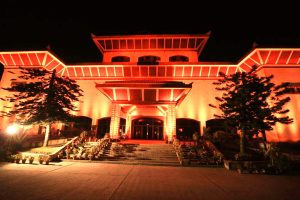Prime Minister Khadga Prasad Sharma Oli’s determined bid to remain in power was dealt a blow on May 10, when he lost a trust vote in the Nepalese House of Representatives. Oli needed 136 votes to win the trust vote in the 271-strong House.
He managed to secure just 93 votes.
Almost 39 months after he became Nepal’s prime minister, his government, which was formed with the support of the Communist Party of Nepal (Maoist Centre), has fallen.
However, this is not the end of the road for Oli; it is too early to write him off. Oli, who also heads the Communist Party of Nepal-Unified Marxist Leninist (CPN-UML), could still return to power.
Monday’s trust vote saw 124 legislators voting against him. Fourteen remained neutral.
Out of 121 CPN-UML legislators, 28 from the dissident Madhav Nepal-Jhala Nath Khanal stayed away from the vote.
Among those who were present at the vote but abstained were lawmakers of the Mahantha Thakur faction of the Janata Samajbadi Party (JSP), the fourth largest party in parliament.
The main opposition party, the Nepali Congress (NC), Oli’s former coalition partner, Communist Party of Nepal-Maoist Center (CPN-MC) and the Upendra Yadav faction of the JSP voted against the government. The NC and the CPN-MC have 61 and 49 lawmakers, respectively.
Monday’s trust vote was a long time in the making. Oli had avoided it for over a year.
Underlying the present political crisis in Nepal is the long-running power struggle within the ruling Nepal Communist Party (NCP), which was formed after the 2017 general elections with the CPN-UML and CPN-MC merging.
Oli’s refusal to share power and his authoritarian style of governance resulted in Madhav Nepal from his own CPN-UML and Pushpa Kamal Dahal of the CPN-MC challenging his leadership.
In December 2020, Oli dissolved parliament and called for fresh elections. A month later the Supreme Court reinstated the House. It subsequently ruled that the NCP be split into its constituents, the CPN-UML and CPN-MC.
When Oli called for a trust vote on May 10, the CPN-MC withdrew its support, reducing the Oli government to a minority.
With the Oli government failing to prove its majority, President Bidhya Devi Bhandari has invoked Article 76(2) of the constitution to invite political parties to stake claim to form a new government. They have time until 9 pm local time Thursday to do so.
Article 76 (2) says that if no party has a clear majority in the House, the president can appoint as prime minister a legislator who commands a majority with the support of two or more parties.
The Nepali Congress is expected to stake a claim to forming a government with the backing of the CPN-MC.
Together they have 110 members. They need another 26 to form a majority government.
The JSB has 32 legislators. With their support, a new coalition government is possible. But the party is divided. The Thakur faction has ruled out joining the CPN-MC led government.
The CPN-UML could still return if it holds together; that is if the Madhav Nepal-Khanal faction stays with Oli. It will need the support of the Thakur faction of the JSB, however. If these two team up, the CPN-UML (with 121 seats) and the Thakur faction (with 17 seats) will have 138 parliamentarians on their side, enough to form the new government.
Hectic consultations are on to form the new government.
The new government will have to prove its majority within 30 days. Should it fail to do so, the president is mandated under Article 76(3) to appoint as prime minister the leader of the largest party in parliament.
That would be Oli as the CPN-UML has the largest number of legislators.
He will have to prove majority support in parliament within 30 days, however. That will bring Nepal back to the situation that existed before Monday’s trust vote.
While Nepal’s politicians are busy cobbling up the numbers to form a government, the surging number of COVID-19 cases in the country has gone by largely ignored.
On Monday, Nepal’s total tally of COVI-19 cases touched 403,794 with 9,127 new infections and 139 fatalities being reported in the preceding 24 hours. The country has reported 3,859 deaths due to pandemic so far.
Of the 1,300 people tested last week ahead of Monday’s House session, 27 parliamentarians and 140 parliamentary secretariat staff tested positive.
Yet the trust vote went ahead.
If only Oli had used his grit, which he has displayed over the past two years to cling to power, to fight the pandemic and prepare Nepal for the second wave, the country wouldn’t be staring at a public health disaster.

































